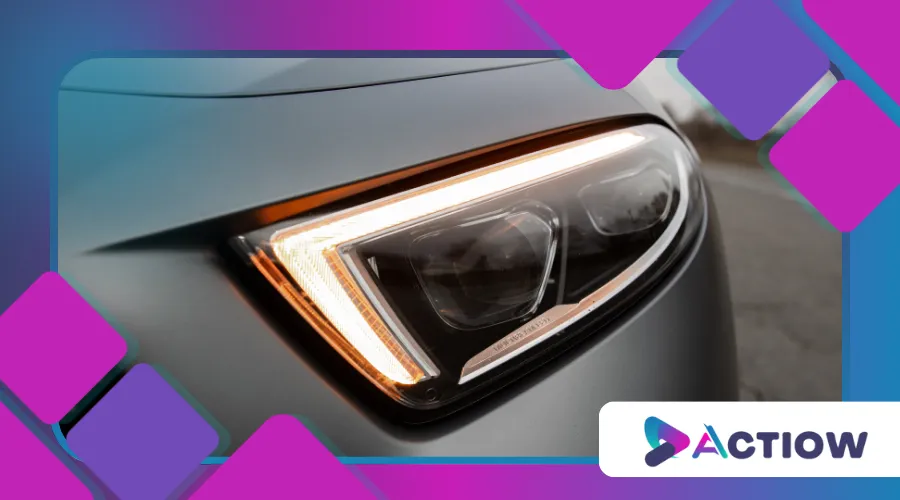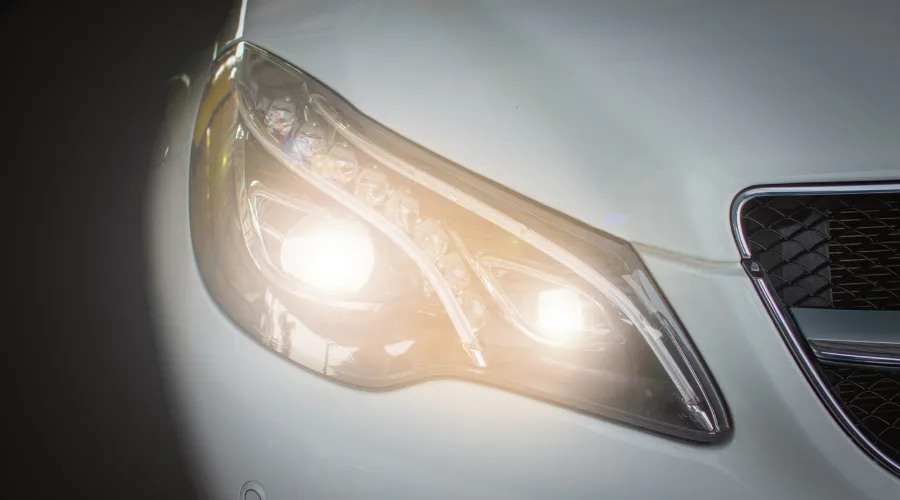Cars with Smart Lights: Revolutionizing Night Visibility

Anúncios
Imagine driving down a winding road at dusk, where shadows blur the edges of your path.
Cars with smart lights are transforming this experience, illuminating the way with precision and intelligence.
These advanced lighting systems adapt to conditions, enhancing safety and comfort for drivers.
Anúncios
Unlike traditional headlights, smart lights use cutting-edge technology to anticipate and react, offering a glimpse into the future of automotive innovation.
But how exactly do they work, and why are they becoming indispensable?
Nighttime driving has always carried risks.
The National Highway Traffic Safety Administration (NHTSA) reports that 50% of fatal crashes in the U.S. occur at night, despite only 25% of driving happening after dark.
This stark statistic underscores the need for better visibility solutions.
Smart lighting systems address this by dynamically adjusting to environmental factors, from weather to road curvature.
Let’s explore how cars with smart lights are redefining nighttime safety, their core technologies, and their broader impact on driving.
The Evolution of Automotive Lighting
Headlights have come a long way from the dim, static beams of early vehicles.
Incandescent bulbs gave way to halogen, then xenon, and now LED and laser technologies dominate.
Cars with smart lights build on these advancements, integrating sensors, cameras, and software to create adaptive lighting systems.
These systems don’t just shine brighter—they think smarter.
Take the example of the 2025 Audi Q8 e-tron.
Its matrix LED headlights use a grid of tiny, individually controlled LEDs to shape light patterns in real time.
If an oncoming car approaches, the system dims specific segments to avoid glare while keeping the rest of the road brightly lit.
This precision is like a painter adjusting strokes to perfect a canvas, ensuring clarity without blinding others.
Such innovation marks a leap from the one-size-fits-all approach of traditional headlights.
As automotive technology continues to evolve, we can expect even more sophisticated lighting solutions that enhance safety and driving experience.
Moreover, the integration of smart lighting technologies not only improves visibility but also contributes to overall vehicle performance and efficiency.
How Smart Lights Work: Technology Breakdown
The magic of cars with smart lights lies in their ability to adapt.
These systems rely on a trio of components: sensors, cameras, and control units.
Sensors detect ambient light, weather conditions, and vehicle speed, while cameras identify obstacles, pedestrians, or other vehicles.
The control unit processes this data, adjusting light intensity, direction, and spread instantly.
For instance, Mercedes-Benz’s Digital Light system, found in models like the 2025 S-Class, projects light with over 1.3 million micro-mirrors per headlight.
It can highlight pedestrians or project road signs directly onto the pavement.
This isn’t just illumination—it’s a conversation between car and environment.
Rainy nights? The system widens the beam to cut through fog.
Sharp curve ahead? It pivots the light to follow the road’s contour.
Here’s a breakdown of key features in smart lighting systems:
| Feature | Function |
|---|---|
| Adaptive Beam Control | Adjusts light direction based on steering angle and road curvature. |
| Glare-Free High Beams | Dims specific areas to avoid blinding oncoming drivers. |
| Weather-Adaptive Lighting | Modifies beam intensity for rain, fog, or snow. |
| Pedestrian Detection | Highlights people or animals with targeted light to alert drivers. |
These features work in harmony, making cars with smart lights not just reactive but proactive, anticipating challenges before they arise.
As technology advances, we can expect to see even more innovative features that enhance safety and convenience.
The future of smart lighting is promising, with ongoing research focused on improving sensor accuracy and response times.
+ Onboard Diagnostic Systems: How to Monitor Your Car’s Health
Safety Benefits: A Clearer Path to Survival
Why do we need smarter headlights?
Consider this: human eyes struggle in low-light conditions, and traditional headlights often fall short in complex scenarios.
Cars with smart lights tackle this head-on.
By dynamically adjusting to conditions, they reduce driver fatigue and improve reaction times.
A 2023 study by the Insurance Institute for Highway Safety (IIHS) found that vehicles with adaptive headlights reduced nighttime crash rates by 10% compared to those with standard headlights.
Picture a rural road at midnight, with deer lurking in the shadows.
A BMW X5 equipped with laser headlights detects the animal’s movement via infrared sensors and projects a focused beam to highlight it.
The driver, alerted early, slows down, avoiding a collision.
This isn’t science fiction—it’s happening now.
Smart lights don’t just illuminate; they save lives by giving drivers precious seconds to react.
The integration of smart lights into more vehicles could significantly enhance overall road safety, reducing accidents and saving lives.
As these technologies become more widespread, we can anticipate a notable decrease in nighttime accidents and improved overall traffic safety.

Beyond Safety: Enhancing Driver Comfort
Smart lighting isn’t only about preventing accidents—it’s about making driving more pleasant.
Glare from oncoming traffic can strain eyes, causing discomfort or even temporary blindness.
Cars with smart lights mitigate this by selectively dimming high beams without sacrificing visibility.
This creates a smoother, less stressful experience, especially on long drives.
Moreover, these systems enhance aesthetic appeal.
The crisp, white light of LEDs or lasers offers better color rendering, making road signs and lane markings pop.
It’s like upgrading from a grainy black-and-white TV to 4K—details become vivid, and the journey feels more engaging.
For drivers, this blend of comfort and clarity transforms night drives from daunting to delightful.
In addition to comfort, smart lighting systems can also contribute to a more enjoyable driving experience by enhancing the ambiance of the vehicle’s interior.
These advancements not only focus on safety but also prioritize the overall driving experience, making it more enjoyable and less stressful.
++ Cars with 360-Degree Cameras: How They Make Driving Easier
Environmental and Efficiency Gains
Smart lights also shine in sustainability.
LED-based systems use up to 50% less energy than traditional halogen bulbs, extending battery life in electric vehicles (EVs).
For example, the Tesla Model Y’s adaptive LED headlights consume minimal power while delivering superior brightness.
This efficiency aligns with the auto industry’s push toward greener technologies, reducing the carbon footprint of nighttime driving.
Additionally, smart lights have longer lifespans—often exceeding 10,000 hours—compared to halogen’s 1,000 hours.
This durability cuts maintenance costs and waste.
The table below compares traditional and smart lighting systems:
| Aspect | Traditional Headlights | Smart Lights |
|---|---|---|
| Energy Consumption | High (60-100W) | Low (20-40W) |
| Lifespan | ~1,000 hours | ~10,000+ hours |
| Adaptability | None | Dynamic and responsive |
| Maintenance Cost | Higher | Lower |
This efficiency doesn’t just benefit drivers—it supports a broader shift toward sustainable automotive design.
For further insights on sustainable automotive technologies, check out The International Council on Clean Transportation.
As the industry continues to innovate, we can expect even greater advancements in energy efficiency and sustainability.

Challenges and Limitations
No technology is flawless.
Cars with smart lights face hurdles, including cost.
Advanced systems can add thousands to a vehicle’s price, limiting their availability to premium models.
Retrofitting older cars is also tricky, as these systems require integrated sensors and software not easily added post-purchase.
Regulatory challenges persist, too.
In the U.S., federal rules have lagged behind Europe, where adaptive headlights have been legal for over a decade.
The NHTSA only recently approved glare-free high beams in 2023, slowing adoption.
And while smart lights excel in urban or highway settings, their performance in extreme conditions—like heavy snowstorms—can still be inconsistent, as sensors may struggle to interpret data.
Addressing these challenges will be crucial for the widespread adoption of smart lighting technologies in the automotive industry.
As manufacturers work to overcome these barriers, we may see more accessible and affordable smart lighting options in the future.
The Future of Smart Lighting
What’s next for cars with smart lights?
The horizon is bright.
Emerging technologies like LiDAR-integrated headlights could enhance precision, mapping roads in 3D for unparalleled visibility.
Augmented reality (AR) integration is another frontier—imagine headlights projecting navigation cues directly onto the road, guiding drivers like a virtual co-pilot.
Autonomous vehicles stand to benefit immensely.
Self-driving cars rely on sensors, but smart lights add an extra layer of environmental awareness, improving navigation in low-visibility conditions.
As costs decrease and regulations catch up, expect these systems to become standard, not just a luxury.
The continuous evolution of smart lighting technology will likely lead to even more innovative solutions that enhance both safety and convenience for drivers.
With ongoing research and development, the future of smart lighting holds exciting possibilities that could redefine nighttime driving.
Why It Matters: A Brighter, Safer Tomorrow
Cars with smart lights are more than a tech trend—they’re a paradigm shift.
They address the timeless challenge of nighttime driving with a blend of safety, comfort, and efficiency.
By adapting to the world around them, these systems empower drivers to navigate with confidence, whether dodging a deer or cruising through fog.
Isn’t it time we all saw the road more clearly?
From reducing crash risks to enhancing sustainability, smart lights are paving the way for a future where night driving is as safe as day.
As automakers continue to innovate, these systems will only get smarter, proving that sometimes, the brightest ideas come from the simplest need: to see and be seen.
As we embrace these advancements, we can look forward to safer, more enjoyable driving experiences for everyone.
The integration of smart lighting technologies will play a vital role in shaping the future of automotive safety and efficiency.
